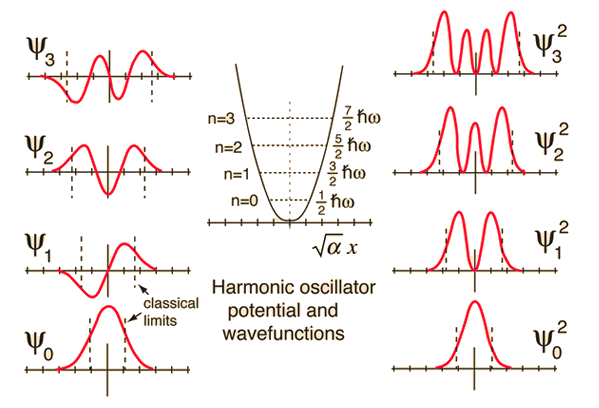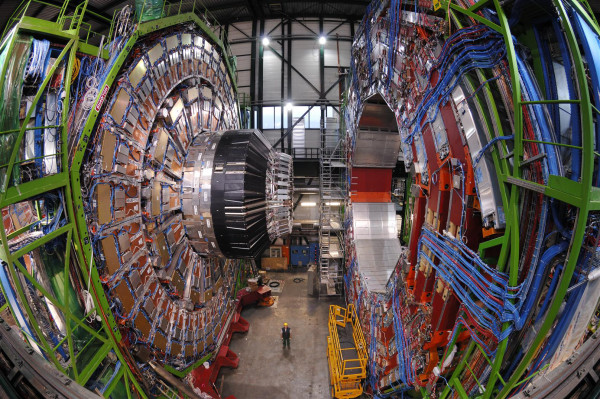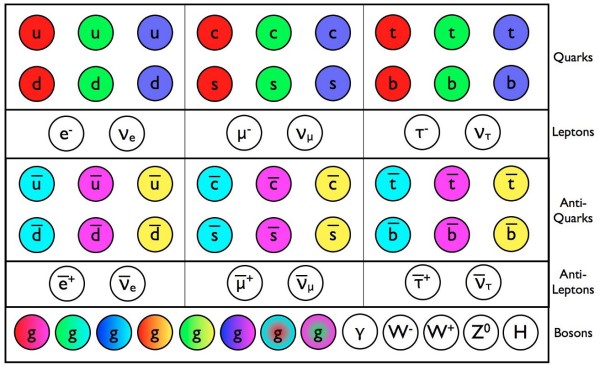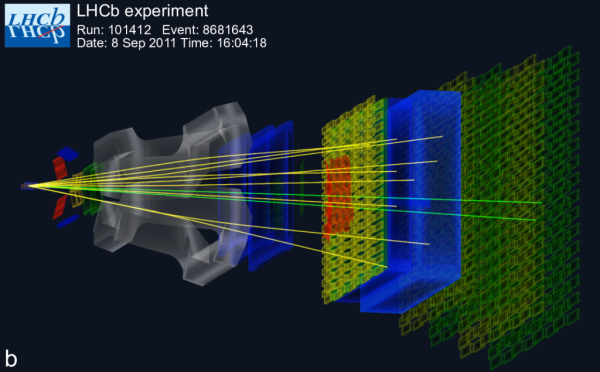"I am quite surprised that it happened during my lifetime. It is nice to be right about something sometimes." -Peter Higgs
The LHC at CERN proved its value, for sure, but there are lots of other opinions floating around. On this and all topics at Starts With A Bang, you're free to have your say! Here's the ground we've covered, in case you missed anything:
- What if we grew a fourth spatial dimension? (for Ask Ethan),
- Obsession, for cats? (for our Weekend Diversion),
- A runaway blue giant (for Mostly Mute Monday),
- "Why do I have to learn this?", (a back-to-school special),
- Will the LHC be the end of experimental particle physics?,
- and The little bit of dark matter we know (for Throwback Thursday).
I also had a couple of fun new pieces over at Forbes:
- Why The Black Hole Information Paradox Is Such A Problem, and
- New Record Set For Most Distant Galaxy Ever Found In The Universe.
Our Patreon supporters are making great things happen! I've already bought an awesome microphone in anticipation of creating new monthly podcasts; we're 90% of the way towards our goal! That said, let’s take a trip into our Comments of the Week!
From Ross on my colorforms analogy for a 2-dimensional world: "interesting post, but why did it include a picture of Ghostbusters committing sex acts on each other. Did you really not notice that?"
What happens in flatland stays in flatland, so I've heard. (No, I didn't notice, but as soon as you mentioned it I feel nothing but shame.)
Image credit: ©2010–2015 jawoltze of deviantART, via http://jawoltze.deviantart.com/art/4D-The-Fourth-Dimension-183161239.
From Denier on what's possible in General Relativity: "Then General Relativity is wrong. If something is mathematically possible, then it happens. I’m fully aware of how thoroughly tested GR has been, but if predictions don’t match observations then you need to check the math. GR is one of the most successful theories of all time but because it does have known shortcomings such as on the singularity side of an Event Horizon, GR should be treated as a rule of thumb rather than the holy grail of universal mechanics."
I understand -- I think I understand -- exactly where this sentiment comes from. There's a famous quote in physics that goes something like, "Anything that's not forbidden is mandatory." It's actually not from physics, though, and it's not actually completely true.
 Image credit: R Nave of hyperphysics at Georgia State, via http://hyperphysics.phy-astr.gsu.edu/hbase/quantum/hosc7.html.
Image credit: R Nave of hyperphysics at Georgia State, via http://hyperphysics.phy-astr.gsu.edu/hbase/quantum/hosc7.html.
The way it's normally applied to physics is through quantum mechanics: if you have an ensemble of possibilities for your outcomes that have a finite probability assigned to them, then if you have either enough systems satisfying those conditions or enough time, it's definitely going to happen.
But this is not the same as saying that all mathematical possibilities that a theory allows are physically possible. That's one of the amazing distinctions between mathematics and physics: mathematics often gives you multiple solutions to a problem, but when you apply the laws of physics (or the rules of your physical system), many of those solutions get rejected. Quantum mechanics may tell you the probability that the electron is in a certain energy state, but the answers it gives for imaginary energy states are rejected as unphysical. General Relativity offers us many options for how our Universe can look, but that doesn't mean the Universe looks like all of those things; we have the Universe we have and it can be described by relativity, but not everything that relativity describes is our Universe!
From eric on whether Obsession for men works on house cats: "Well I’m curious enough so that if I can get a free sample at the department store next time I go, I’ll test out how my house cat reacts to Obsession on human skin and let you guys know. Though it may be a while before I get around to it."
This is actually a test you can do at home, and I'd love to know the results. But fortunately, we don't have to wait for you: according to "Your Cat: The Owner's Manual" by Marty Becker, you can take a fragrant perfume or cologne -- and Obsession for Men works -- and apply it liberally to say, a scratching post, and your cat should go nuts for it. Now, I imagine this may not work on all cats (just as catnip doesn't), but it's worth a try. Also, I'm not 100% sure of Marty, since his credentials include:
He is a founding member of Core Team Oz and the resident veterinarian on "The Dr. Oz Show."
So I'd like some verification, if you ever get around to it! I can verify that my two dogs don't care.
 Image credit: NASA/JPL-Caltech/UCLA, WISE spacecraft, via http://www.jpl.nasa.gov/spaceimages/details.php?id=PIA13455.
Image credit: NASA/JPL-Caltech/UCLA, WISE spacecraft, via http://www.jpl.nasa.gov/spaceimages/details.php?id=PIA13455.
From Orion M Guy on mass in motion: "Here is a really interesting question – if Matter/Mass here on earth gets heavier the faster it moves – that it is perceived as “still” when not being handled – as matter is handled and moved it gets heavier – would that mean that if it was still it would get lighter?"
The great thing about Einstein is that it makes concepts such as "mass" a little tough to define absolutely. If I take a mass at rest and an identical mass in motion, they have different total energies, exert different forces, and they respond differently to a gravitational field. But they have the same rest masses as one another. There was a concept that was used in physics for nearly a century known as "relativistic mass," which accounts for exactly this effect you allude to. It has fallen out of favor, as we separate out the "motion" part from the "rest mass" part now, but both formulations are equivalent. So in a sense, yes, but if you think about "rest mass" that is always invariant.
 Image credit: NASA / JPL-Caltech, via http://www.spitzer.caltech.edu/images/5517-sig12-014-Massive-Star-Makes….
Image credit: NASA / JPL-Caltech, via http://www.spitzer.caltech.edu/images/5517-sig12-014-Massive-Star-Makes….
From TBC on the thing that "kicked" this star: "If it’s remarkable that Zeta Oph is moving at 24km/s, note that its “kicker”, pulsar PSR B1929+10, is moving much faster at 177km/s according to the ESA link."
That is correct, but this is not uncommon! Supernova explosions are often asymmetrical, and if they occur in a binary system, we have the conservation of momentum going on. The star, ζ Ophiuchi, from our Mostly Mute Monday post is about 20 times the mass of the Sun; pulsars at most are about three times the mass of our Sun.
So all things being equal, seven times the speed indicates it should be roughly one-seventh the mass, which is pretty remarkably consistent with what we expect! I'll take this as a victory for classical physics, if you don't mind.
From Rosie Redfield, who offers a contrarian viewpoint to mine, "I disagree. When we teach students material that they won’t have any use for in the future, it’s not their fault that they’re :…unmotivated, uninterested, or simply trying to avoid doing the work that they don’t want to do…”.
Why can’t we have our students exercise their brains and build their skills by learning material that they will actually use? If we can’t come up with real-life uses for what we’re teaching, we should back off and reconsider whether we might be teaching the wrong stuff."
This is a well-reasoned, intelligent sentiment that you and I disagree are going to disagree on entirely. Not everything that's going to make you a stronger person is something that is necessarily utilitarian. Some things you learn not knowing how they'll be useful or whether they'll be useful. Down the road, sometimes it is helpful, sometimes it is useful, sometimes it isn't, and sometimes, you never know.
I took Suzuki violin as a kid, sang in my school's chorus and later played the trumpet for six years. Was it useful to me? I did it long past the point of enjoyment, so arguably it wasn't. Yet when I wanted to learn guitar years later, I had a "knack" for it that I doubt I would have without that background.
I took tons of math that never proved useful to me -- and still hasn't -- but I would argue that learning those forms of math has potentially helped me learn the branches of math that have been useful to me in my career. I don't think you can ever know how your brain will grow as a result of what you learn; only that it won't grow in those ways if you don't learn.
So choose learning, or suffer the consequences of having the inferior mind to the one you could've had. As the student, it's your choice.
Image credit: jamtoons, via iStockPhoto and Getty Images, at http://www.istockphoto.com/vector/school-subjects-doodles-25933291.
From Candice H. Brown Elliott on the ensuing discussion about homeschooling: "well a day… talk about “thread hijacking” !"
I agree. Of course, the comment section is the place to go off on whatever tangents you want, so I don't mind. I only ask -- and it's not an order, just an ask -- the following:
- That you be decent to one another.
- That you treat each other with a minimum modicum of respect, even when you disagree.
- And that you don't go off the deep end, promoting your own crazy crackpot theories.
That's my ask. That is all.
From Richard Mitnick on the ILC: "No. Flat out no. The ILC is on the way and will be built. What it will find is anybody’s guess."
There is a lot of motivation for the ILC, and there are people who want to build it. But unless the LHC observes something that strongly motivates beyond-the-standard-model physics accessible at colliders, there's no point. Building the ILC to confirm what we already know and to learn nothing else would be a disaster. I want it, don't get me wrong, but the ILC is not funded and is in no way "on the way" as you would hope.
From eric on the limits of what we know now: "Or were you just making the pragmatic argument, that we’ve reached the limit of what current technology or even reasonably extrapolated future technology can discover?"
I would never say "the Standard Model" is all there is; we know that's untrue! We know, for example:
- neutrinos have mass,
- there's no strong CP violation,
- there's a matter/antimatter asymmetry,
- there is a reason for the hierarchy problem,
- there's a particle responsible for dark matter,
- and something is causing dark energy,
among others. These all likely have their solution in beyond-the-Standard-Model physics. But will we find any evidence of this physics -- if we don't see it at the LHC's energies -- at energies up to, say, 20,000 times what the LHC can reach? (What we'd get if we built an LHC-equivalent around our equator.) I don't think so.
Low-energy SUSY, low-energy extra dimensions, low-energy leptoquarks, etc., are motivated by the question of "what can we find at colliders," not by "where does the Standard Model indicate the energy scale at which we need new physics?" That latter scale is no lower than 10^10 GeV, and I don't think anyone has a realistic proposal for how we'd build something like that. Unless we achieve energy gains more than 100,000 times what the LHC does per meter, I don't know how this is plausible.
And finally, from emptyspacehasmass on the little bit of dark matter we know: "The Milky Way’s halo is not a clump of dark matter traveling along with the Milky Way. The Milky Way’s halo is lopsided due to the matter in the Milky Way moving through and displacing the dark mass, analogous to a submarine moving through and displacing the water."
First off, the "lopsided halo" observation comes from the fact that we appear to have a higher density of gas -- not total mass or dark matter -- in one direction of the Milky Way than the other. That could, legitimately, simply be to a natural variation in how much gas is present in certain locations.
Second, as far as we can tell, which means to the limits of our current experiments and technology, there is no interaction at all between baryonic matter and dark matter, much less the exclusion rule you propose. There may be a relationship between the "cuspy" halo problem and normal matter, but then why is this a bigger problem in smaller (lower-mass) galaxies than larger ones?
My point is to say, ideas are a dime-a-dozen. Ill-motivated ideas are easy to come up with. But a good idea? An idea worth considering and exploring? It requires you know and consider the full suite of scientific evidence concerning a problem, so that what you propose doesn't just sound good to you, but addresses all of what's known. Good for you for having an idea, but do be aware that this idea doesn't meet those criteria.
Thanks for a great week of your thoughts, and I'm looking forward to the next one!










Some things you learn not knowing how they’ll be useful or whether they’ll be useful.
No kidding. A quarter century after I took a mandatory college trigonometry course, I'm suddenly finding a use for it because my wife is designing a computer game that uses a hexagonal playing field.